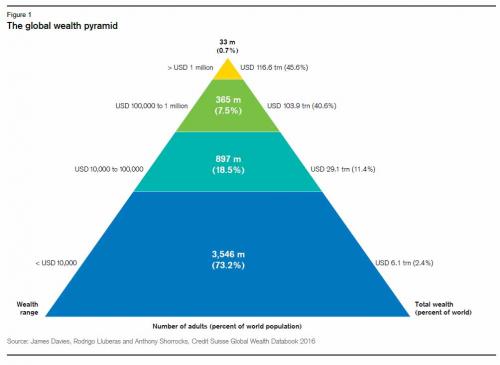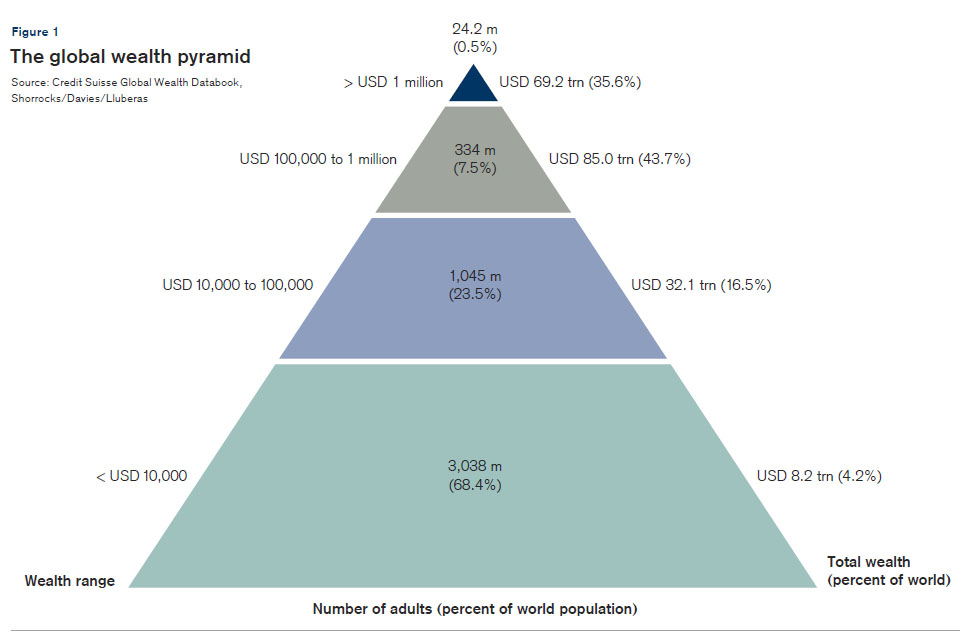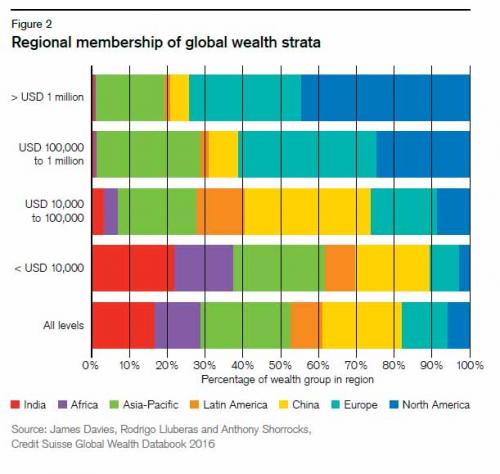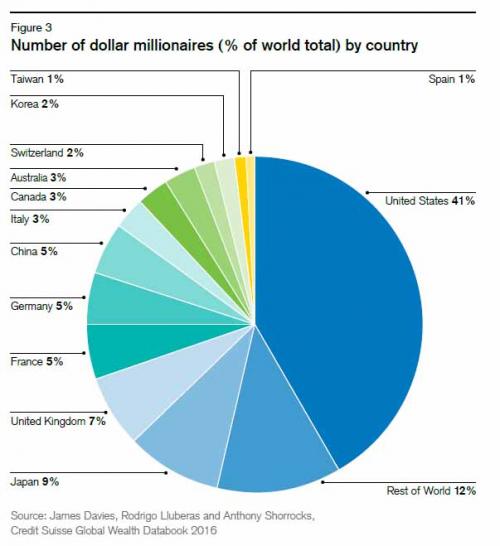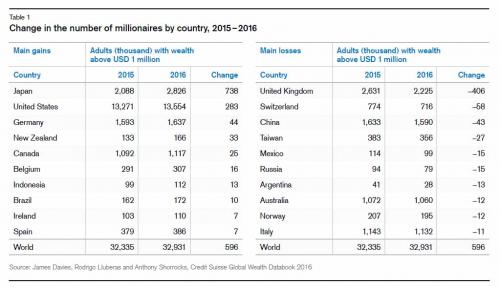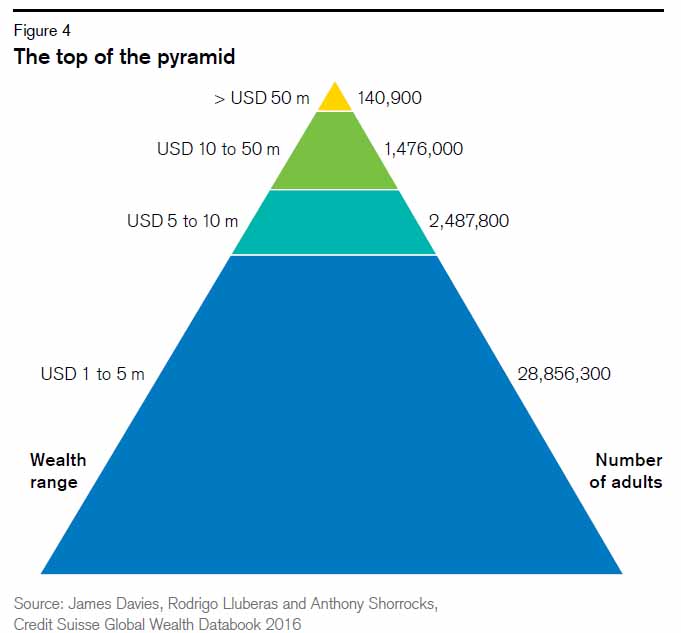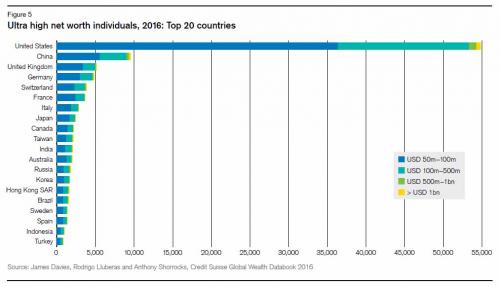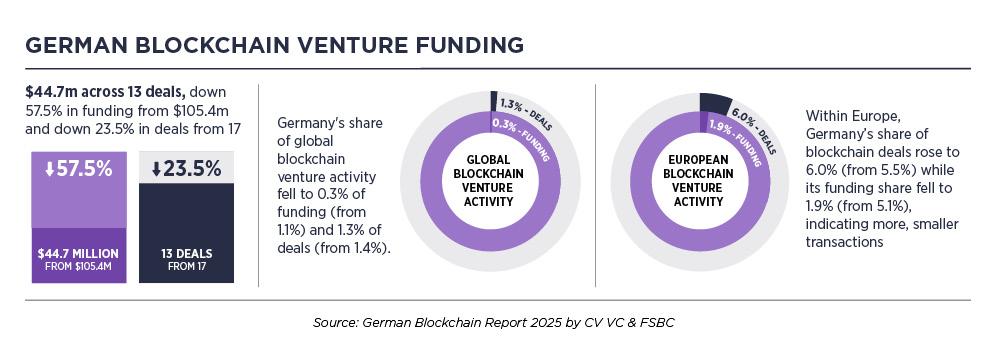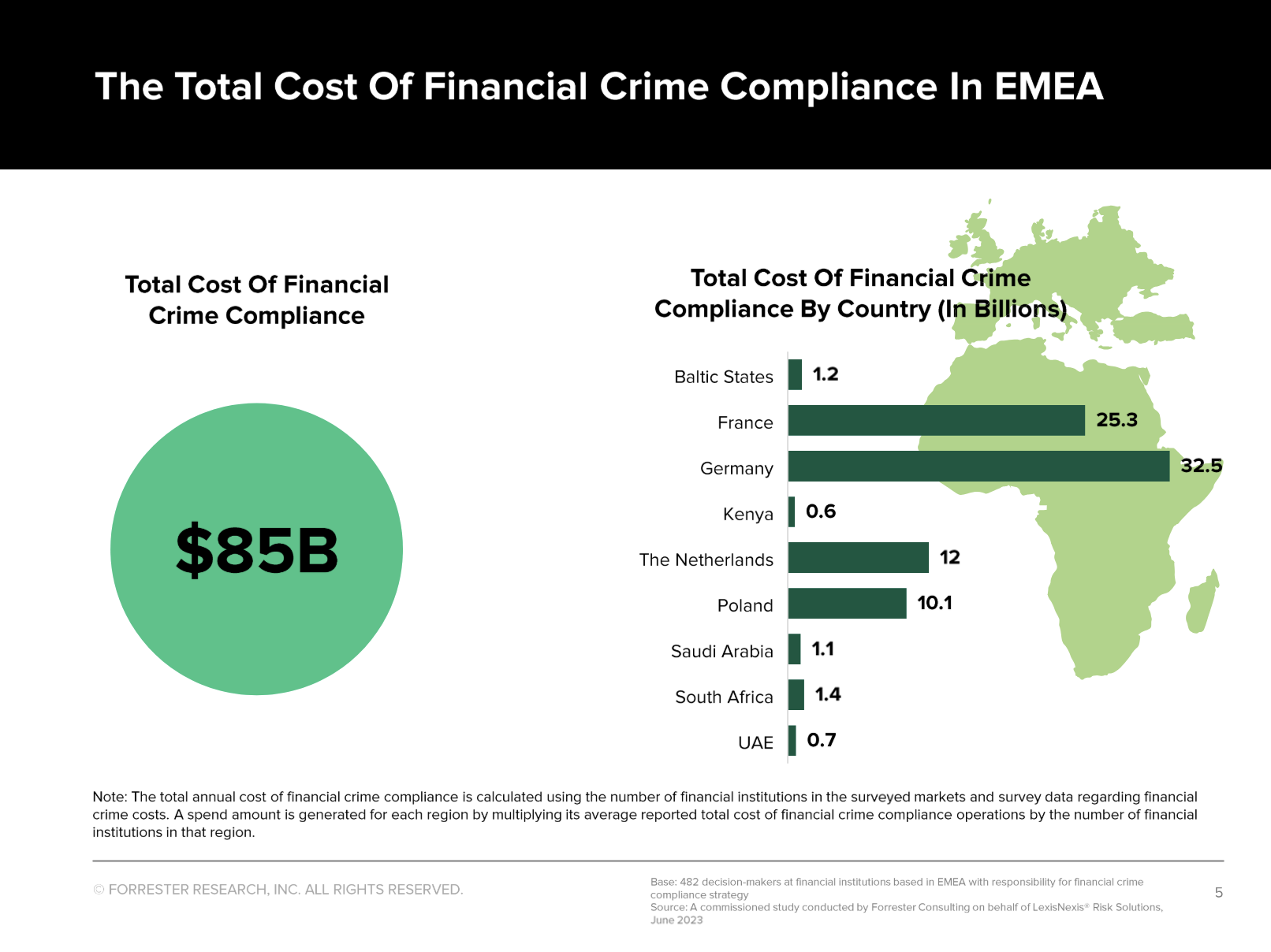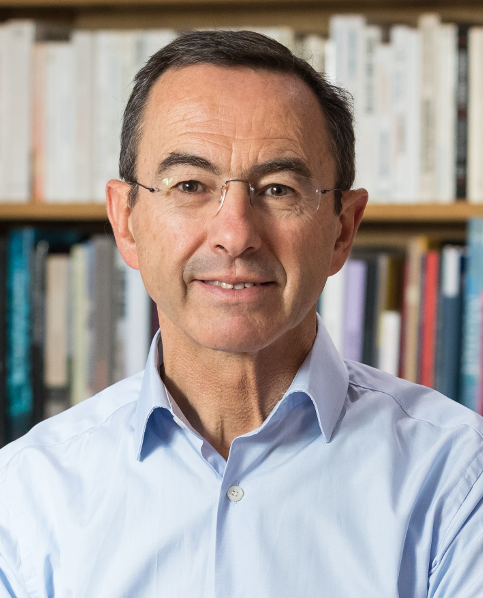| Today Credit Suisse released its latest annual global wealth report, which traditionally lays out what is perhaps the biggest reason for the recent “anti-establishment” revulsion: an unprecedented concentration of wealth among a handful of people, as shown in its infamous global wealth pyramid, an arrangement which as observed by the “shocking” political backlash of the past few months suggests that the lower ‘levels’ of the pyramid are increasingly unhappy about.
As Credit Suisse tantalizingly shows year after year, the number of people who control just shy of a majority of global net worth, or 45.6% of the roughly $255 trillion in household wealth, is declining progressively relative to the total population of the world, and in 2016 the number of people who are worth more than $1 million was just 33 million, roughly 0.7% of the world’s population of adults. On the other end of the pyramid, some 3.5 billion adults had a net worth of less than $10,000, accounting for just about $6 trillion in household wealth. And inbetween is the so-called global middle class – those 1 billion people who rising anger at the status quo made Brexit and Trump possible. |
Global Wealth Pyramid |
| Incidentally, we tracked down the first Credit Suisse report we found in this series from 2010, where the total wealth of the top “layer” in the pyramid was a modest $69.2 trillion for the world’s millionaires. It has nearly doubled in the 6 years since then. Meanwhile, the world’s poorest have gotten, you got it, poorer, as those adults who were worth less than $10,000 in 2010 had a combined net worth of $8.2 trillion, a number which has since declined to $6.1 trillion in 2016 despite a half a billion increase in the sample size. The same goes for the layer right above, also known as the “middle class.”
How about the very top? Things here are even more nuanced, with 28.9 million people whose net worth is between $1 and $5 million gradually tapering off to just 140,900 Ultra High Net Worth individuals who control more than $50 million in assets each. Of these, 50,800 are worth at least USD 100 million, and 5,200 have assets above USD 500 million. The total number of UHNW adults is about 3% higher than a year ago (4,100 individuals), and the increase has been relatively uniform across regions, except for the higher than average rise in Asia- Pacific countries (10%) |
Global Wealth Pyramid |
| Wealth differences within and between countries
Wealth differences between individuals occur for many reasons. Variation in average wealth across countries accounts for much of the observed inequality in global wealth, but there is also considerable disparity within countries. Those with low wealth are disproportionately found among the younger age groups, who have had little chance to accumulate assets. Others may have suffered business losses or personal misfortune, or live in regions where prospects for wealth creation are more limited. Opportunities are also sometimes constrained for women or minorities. In contrast, many individuals can be found at the other end of the spectrum who have acquired large fortunes through a combination of talent, hard work and good luck. The wealth pyramid in Figure 1 captures these differences. The large base of low wealth-holders underpins higher tiers occupied by progressively fewer adults. We estimate that 3.5 billion individuals – 73% of all adults in the world – have wealth below USD 10,000 in 2016. A further 900 million adults (19% of the global population) fall in the USD 10,000–100,000 range. While average wealth is modest at the base and in the middle tiers of the pyramid, total wealth there amounts to USD 35 trillion, underlining the economic importance of this often overlooked segment. The base of the pyramid The layers of the wealth pyramid are quite distinctive. The base tier has the most even distribution across regions and countries (Figure 2), but also the most uneven range of personal circumstances. In developed countries, only about 20% of adults fall within this category, and for the majority of these individuals, membership is either transient – due to business losses or unemployment, for example – or a lifecycle phase associated with youth or old age. In contrast, more than 90% of the adult population in India and Africa falls within this range. For many residents of low-income countries, life membership of the base tier is the norm rather than the exception. |
Regional Membership of Global Wealth Strata |
| Mid-range wealth
In terms of global wealth, USD 10,000 –100,000 is the mid-range band. It covers around 900 million adults who represent a high proportion of the middle class in many countries. The average wealth of this group is quite close to the overall global mean wealth, and its combined net worth of USD 29 trillion provides it with considerable economic clout. India and Africa are under-represented in this segment, whereas China’s share is disproportionately high. China and India provide an interesting contrast. India accounts for just 3.1% of those with mid-range wealth, and that share has changed very little during the past decade. In contrast, China accounts for 33% of those with wealth between USD 10,000 and USD 100,000, ten times the number of Indians, and double the proportion of Chinese in 2000. The high wealth bands The top tiers of the wealth pyramid – covering individuals with net worth above USD 100,000 – comprised 5.9% of all adults at the turn of the century. The proportion rose rapidly until the financial crisis, but has remained quite stable since that time. It currently comprises 8.2% of the global total, nearly the same as in mid-2015. Regional composition differs markedly from the strata below. Europe, North America and the Asia-Pacific region (omitting China and India) together account for 89% of the group, with Europe alone providing 144 million members (36% of the total). This compares with just 5 million adult members (1.2% of the global total) in India and Africa combined. The pattern of membership changes once again for the US dollar millionaires at the top of the pyramid. The number of millionaires in any given country is determined by three factors: the size of the adult population, average wealth, and wealth inequality. The United States scores high on all three criteria, and has by far the greatest number of millionaires at 13.6 million, or 41% of the worldwide total (Figure 3). For many years, Japan held second place in the millionaire rankings by a comfortable margin – with 13% of the global total in 2011, for example, which was double the number of the third placed country. After a drop this year, the United Kingdom falls to third place with 7% of millionaires worldwide, followed by Germany, France, and China with 5% each, and Italy, Canada, and Australia with 3% each. Switzerland, Korea, Spain, and Taiwan are the four other countries with more than 350,000 millionaires, which is the minimum requirement for a one percent share of the global total. |
Number of Dollar Milionaires by Country |
| Changing membership of the millionaire group
Year-on-year variations in the number of millionaires can often be traced to real wealth growth and exchange rate movements. Last year, we reported that widespread depreciation against the US dollar had resulted in a significant reduction in the number of millionaires between mid-2014 and mid-2015. This year, the changes in both directions have been relatively modest: a net increase of 596,000 or 2%. Japan reversed the trend of recent years, adding more than a third to its total (up 738,000 to 2.8 million). Millionaire numbers rose again in the United States, but only by 283,000, which is less than the typical rise in the period since the financial crisis. The downside was experienced by the United Kingdom, which lost around 15% of its millionaires (406,000 adults), and to a lesser extent by Switzerland (down 58,000), and China (down 43,000). High net worth individuals The usual source of information on wealth data – official household surveys – tends to become less reliable at higher wealth levels. To estimate the pattern of wealth holdings above USD 1 million, we therefore supplement the survey data with figures from “rich lists” such as the Forbes annual tally of global billionaires. These rich list data are pooled for all the years since 2000, and well-known statistical regularities are then used to estimate intermediate numbers in the top tail which are consistent with the Forbes data. This produces plausible estimates of the global pattern of asset holdings in the high net worth (HNW) category from USD 1 million to USD 50 million, and in the ultra-high net worth (UHNW) range from USD 50 million upwards. While the base of the wealth pyramid is occupied by people from all countries at various stages of their lifecycles, HNW and UHNW individuals are heavily concentrated in particular regions and countries, and tend to share more similar lifestyles, for instance participating in the same global markets for luxury goods, even when they reside in different continents. The wealth portfolios of these individuals are also likely to be more similar, with a focus on financial assets and, in particular, equities, bonds and other securities traded in international markets. There are 2.5 million adults worth between USD 5 million and 10 million, and 1.5 million more have assets in the USD 10– 50 million range. In terms of HNW membership, Europe briefly overtook North America in 2007, but North America regained the lead in 2010, and now accounts for a much greater number, namely 14.7 million (45% of the total), compared to 9.8 million (30%) in Europe. Asia-Pacific countries, excluding China and India, have 6.0 million members (18%), and another 1.6 million are found in China (5% of the global total). The remaining 816,000 HNW individuals (2% of the total) reside in India, Africa or Latin America. |
Change in The Number of Milionaires by Country, 2015-2016 |
| For mid-2016, we estimate that there are 33.0 million HNW adults with wealth between USD 1 million and USD 50 million, of whom the vast majority (28.9 million) fall in the USD 1– 5 million range (Figure 4). |
CS-Wealth |
| Ultra-high net worth individuals
Our calculations suggest that 140,900 adults worldwide can be classed as UHNW individuals, with net worth above USD 50 million. Of these, 50,800 are worth at least USD 100 million, and 5,200 have assets above USD 500 million. The total number of UHNW adults is about 3% higher than a year ago (4,100 individuals), and the increase has been relatively uniform across regions, except for the higher than average rise in Asia- Pacific countries (10%). North America dominates the regional rankings, with 73,400 UHNW residents (52%), while Europe has 29,800 (21%), and 18,800 (13%) live in Asia-Pacific countries, excluding China and India. Among individual countries, the United States leads by a huge margin with 70,400 UHNW adults, equivalent to 50% of the group total (Figure 5). This is a small increase of 500 compared to mid- 2015. China occupies second place with 11,000 UHNW individuals (up 640 on the year), followed by Germany (6,100, up 500). The United Kingdom lost by far the greatest number of UHNW individuals (down 700 to 4,700), but still heads France (4,100, up 600). In contrast, Japan gained the most (3,600, up 1,000), and now occupies sixth place. Italy (3,300, up 400), Canada (2,900, up 100), Korea (2,500, up 200), and India (2,300, up 100) are the other countries with the highest numbers of UHNW individuals. |
Ultra High Net Worth Individuals |
The wealth spectrum
The wealth pyramid captures the contrasting circumstances between those with net wealth of a million US dollars or more in the top echelon, and those lower down in the wealth hierarchy. Discussions of wealth holdings often focus exclusively on the top tail. We provide a more complete and balanced picture, believing that the base and middle sections are interesting in their own right. One reason is the sheer size of numbers and their political power. However, their combined wealth of USD 35 trillion also yields considerable economic opportunities, which are often overlooked. Addressing the needs of these asset owners can drive new trends in both the consumer and financial industries. China, Korea and Indonesia are examples of countries where individuals have been rising rapidly through this part of the wealth pyramid. India has not shown similar progress to date, but has the potential to grow rapidly in the future from its low starting point.
While the middle and lower levels of the pyramid are important, the top segment will likely continue to be the main driver of private asset flows and investment trends. Our figures for mid-2016 indicate that there are now nearly 33 million HNW individuals, including 1.6 million in China, and more than 6 million in other Asia-Pacific countries. At the apex of the pyramid, 140,900 UHNW adults are each worth more than USD 50 million. This includes 11,000 UHNW individuals in China (8% of the global total), a 100-fold rise since the turn of the century. A further 8,500 UHNW adults (6% of the total) can be found in Hong Kong, India, Korea, and Taiwan.
Full story here Are you the author? Previous post See more for Next postTags: Asia Pacific,Australia,China,Credit Suisse,Economic inequality,economy,Financial crisis of 2007–2008,France,Germany,Hong Kong,India,Italy,Japan,Latin America,middle-class,newslettersent,Switzerland,Unemployment,United Kingdom,United States









